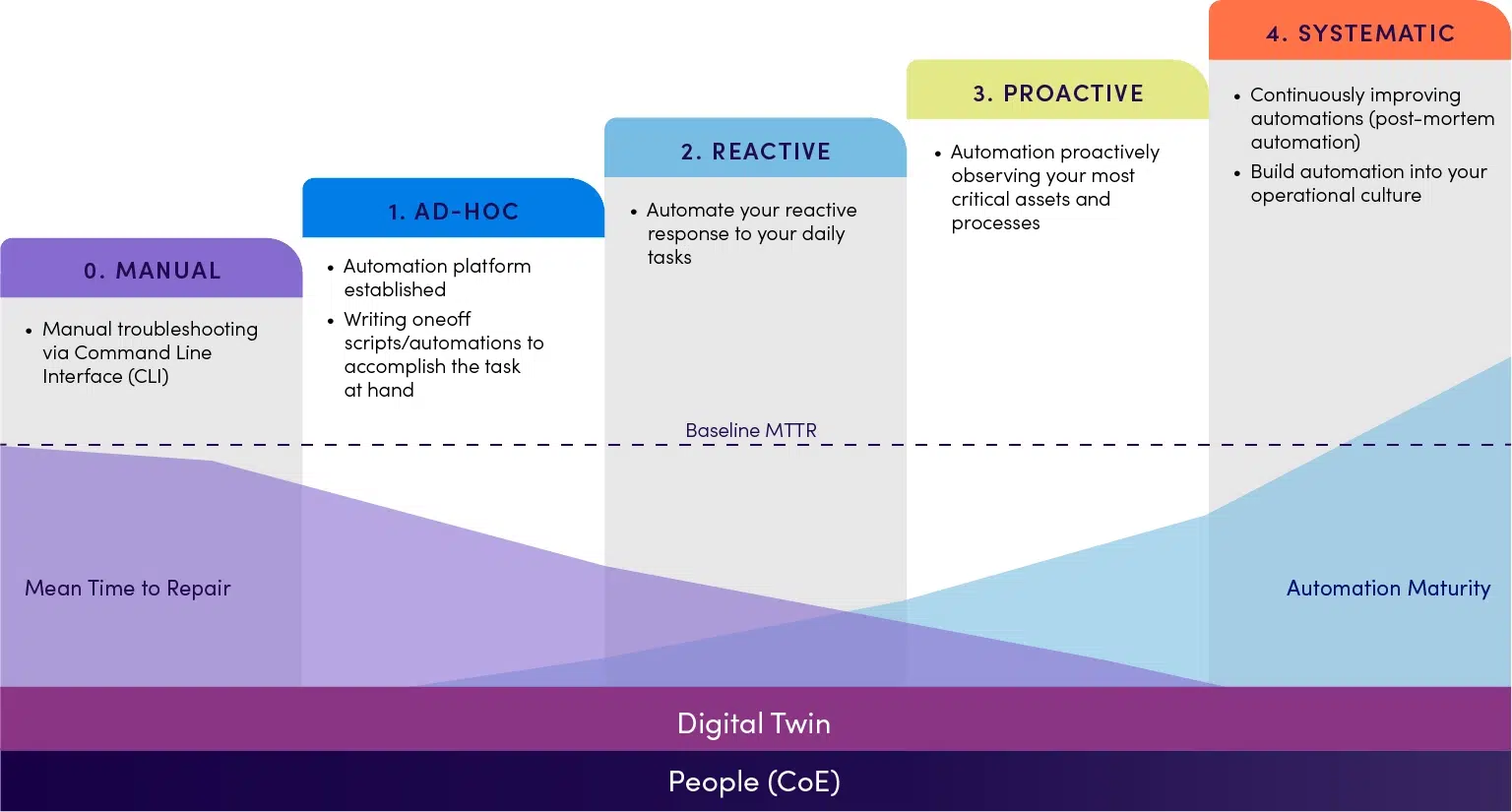Building a Common Language for Automation Maturity
How do we break down Automation?
The key elements of automation can be described in the way it enhances network observability, diagnosis, change management, and more.
Key features:
- AI-Enabled Interface: A user-friendly interface that leverages AI to streamline automation processes.
- Integration: Seamless integration with various network components and tools, creating a cohesive ecosystem.
- Network Observability: Gain deep insights into your network’s health, performance, and behavior.
- Diagnosis: Quickly identify and diagnose network issues with precision.
- Change: Manage network changes effectively and minimize disruptions.
- Auto-Remediation: Automatically resolve certain network issues, reducing manual intervention.
How do we define ‘maturity’?

Maturity in automation is a nuanced journey rather than a binary state. It’s about progressing through different levels of workflow enhancement, guided by a strategic North Star. At the foundational level, automation may be used sporadically, such as with ad-hoc tools and reactive documentation. As maturity develops, automation becomes interactive, integrating tools like automated maps and impact analysis to solve problems faster. Further advancement sees automation as part of collaborative workflows, utilizing dashboards and chatbots for regular engineering tasks. Eventually, systems become integrated, triggering machine-to-machine interactions, and ultimately achieving a preventive state where network design is proactive, event-driven, and self-service enabled.
Levels of Automation Maturity
Automation maturity is a journey, not a binary state. Here’s a look at the progression:
Level 1: Ad Hoc
At this stage, automation is sporadic. One-off scripts and reports are used to address immediate issues, such as applying a script to remediate a problem.
Level 2: Reactive
Automation becomes a managed process with reusable task libraries. It’s triggered by incidents to address recurring issues.
Level 3: Proactive
Automation is used to anticipate problems. By gaining deeper network insights, potential issues can be identified before they occur.
Level 4: Systematic
Automation is ingrained in the culture and workflows. Continuous improvement is achieved through new designs and intelligence, with contributions from everyone involved.
The 10 Dimensions of Automation
Underlay
Focuses on the digital twin and connectivity, managing network devices and their interactions.
Digital Twin
Encompasses four layers: data, topology, path, and intent. It provides a comprehensive view of the network’s architecture and data flow.
2 dimensions:
- 4 layers of data – device layer (assets), topology layer (interconnected devices, neighbors, statuses), Path layer (flow of data), Intent layer (is it supposed to be that way, performance, security, stability) is the intended network design to show how everything is architected and how data flows. This is the foundation for automation.
- Network Visibility and Observability – Visualize and correlate data on maps from reporting of network-wide, live paths. This allows you to understand if my golden config is deviated and if my network is golden. How do you make sense of the data? What is the progression of consuming data and facts? What’s up/down? It’s easier for experts to contextualize what’s going on as you go up the automation maturity stack because observability distills this knowledge for the broader group to have insight and make decisions.
Reactive Services and Workflows
Involves troubleshooting and changing workflows to enhance service delivery.
Diagnosis Automation
Evolves from ad hoc troubleshooting to systematic analysis and optimization of recurring issues.
Change Automation
Progresses, at the lowest level, from one-off changes to a systematic, protective automation process that continuously improves. Take for example, QoS Configurations. Examines any changes from the original architecture, document variations and integrate them into the golden network model for future validation.
Proactive Observability
Anticipates issues by observing network conditions and addressing them before they escalate.
Observability and Auto-Remediation
Develops from symptom-based monitoring to a platform enriched with context and insights from new designs and learnings.
Overlay
Incorporates AI-enabled interfaces and machine-to-machine interactions for seamless integration.
User and Machine Interface
Facilitates higher-level decision-making as automation moves up the technology stack.
AI and Integration
AI plays a pivotal role in orchestrating automation. It enables seamless integration with external systems and allows for intuitive, human-language interactions. AI simplifies complex automation, providing results in a natural, understandable format.
Advancing Automation Maturity
To advance in automation maturity, organizations must build a common language for automation and define their maturity levels. By applying a structured maturity model, IT can build a proactive strategy for automation.
Automation isn’t just about technology—it’s about evolving processes and integrating intelligence into everyday workflows. By understanding and applying the dimensions of automation maturity, organizations can unlock the full potential of their networks, making more informed decisions and creating resilient, efficient systems.
